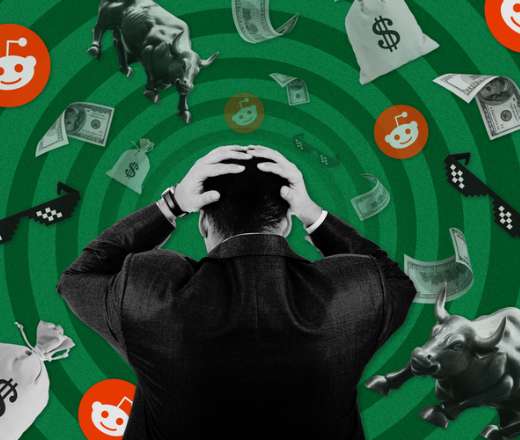It Looks Like A Déjà Vu from 2021, But This Time Could Be Even More Dangerous
Healthcare Triangle Inc. became the most actively traded stock on U.S. exchanges, serving as yet another example of how retail investors have been driving extreme volatility across the stock market in

Healthcare Triangle Inc. became the most actively traded stock on U.S. exchanges, serving as yet another example of how retail investors have been driving extreme volatility across the stock market in recent times.
On Thursday, shares of the little-known healthcare IT company more than doubled to slightly above 5 cents, with trading volume exceeding 3 billion shares. Data compiled by media outlets showed this accounted for about 15% of the total trading volume across U.S. exchanges that day.
The stock of Healthcare Triangle Inc. surged as much as 138% at the open and closed 115% higher. However, there was no apparent positive catalyst to justify this staggering rally.
The total value of trades for the stock that day reached approximately $150 million—nearly seven times the company's market capitalization.
Healthcare Triangle Inc. is a company focused on healthcare information technology. Founded in 2019 and headquartered in California, it primarily provides cloud services, data science, and other solutions for the healthcare and life sciences industries.
Recently, low-priced and heavily shorted stocks have become targets of coordinated retail investor speculation, as they offer lower capital requirements, higher potential returns, and the possibility of triggering a short squeeze by countering institutional short-sellers.
This also makes a bunch of new “Meme stocks”, including Kohl's Corp, Opendoor Technologies, and doughnut restaurant Krispy Kreme.
This scenario is mirroring the 2021 rallies of GameStop and AMC Entertainment, where retail investors targeted struggling companies framed as "challenging Wall Street professionals." For example, Opendoor's stock soared 43% on July 21, with trading volume hitting 1.9 billion shares—nearly 10% of the total U.S. market volume that day. Option market activity even surpassed the single-day peak during GameStop's 2021 frenzy.
Such meme-driven surges can generate windfalls for a select few but pose significant risks for latecomers buying at inflated prices. Since the trading logic is almost entirely detached from business performance or prospects, participating in meme stock speculation is extremely high-risk.
Same Old Playbook: Common Traits of Meme Stocks
The recurring meme stock phenomenon stems from the shared characteristics of their targets. First, they capture the imagination of online communities and are promoted by influencers on social media, often accompanied by memes—images or videos blending pop culture references.
Second, buying these stocks becomes a form of identity or a way to join a specific community, where investors encourage one another to continue buying. Whether it was GameStop and AMC in 2021 or this round's Opendoor, Krispy Kreme, and Beyond Meat Inc., most are well-known consumer brands.
Additionally, these companies typically share two key traits: heavy short interest from professional investors and low stock prices, which lower the barrier to entry for retail traders. When short squeezes occur, short-sellers are forced to buy back shares to cover losses, further fueling irrational price surges.
A Different Landscape: How the 2025 Frenzy Differs from 2021
Though the script is similar, the market environment in 2025 is vastly different from four years ago. In 2021, investors were stuck at home due to the pandemic, armed with government stimulus checks, and exchanging investment tips on social platforms. Today, markets face pressure from high interest rates and trade policy uncertainty, making the resurgence of speculative activity particularly striking.
Reports indicate that this meme stock wave involves fewer stocks than in 2021, but the rallies are more unstable and often short-lived. For instance, Krispy Kreme's stock surged 39% at the open on July 23 but closed with just a 4.6% gain, significantly paring its advance.
This fleeting nature is partly due to institutional traders having developed strategies to quickly identify and react to meme-driven moves, often causing rallies to lose momentum faster.
Influencers and Regulation: The Drivers and Controversies Behind the Frenzy
Behind every frenzy, there are usually posts on platforms like Discord, Reddit's WallStreetBets, or StockTwits. In 2021, it was investor Keith Gill (aka Roaring Kitty) whose bullish posts ignited GameStop's rally.
In the July 2025 episode, Opendoor became a retail trading hotspot after Eric Jackson, founder of Toronto hedge fund EMJ Capital, posted a series of messages on platform X encouraging buying. The stock quickly topped StockTwits' most-active list.
The legality of such actions remains contentious. The SEC monitors market manipulation but must prove intent. If someone promotes a stock to inflate its price and profit, it could be illegal.
Critics argue that meme stock promoters often fail to disclose key details like their holdings, trading timing, or whether they're paid to promote. Others counter that this isn't fundamentally different from activist investors pushing for changes or short-sellers publishing reports for profit.
Why the Frenzy Can't Last
Meme stock manias typically fizzle because they require a constant influx of new buyers to sustain the rally. In 2021, pandemic conditions and market dynamics created the perfect storm for this.
However, recent cases show the frenzies are burning out faster. AMC's May 2021 surge lasted just two days before reversing. In 2024, Faraday Future Intelligent Electric Inc. rocketed from about 4 cents to nearly $4 in a week—only to crash back to penny-stock status within two weeks.
Ultimately, as seen with AMC and GameStop in 2021, the core driver of meme stock rallies is the collective sentiment of retail investors challenging Wall Street's establishment. But a company's underlying business fundamentals eventually take over, bringing the party to an end.
Disclaimer: The views in this article are from the original Creator and do not represent the views or position of Hawk Insight. The content of the article is for reference, communication and learning only, and does not constitute investment advice. If it involves copyright issues, please contact us for deletion.